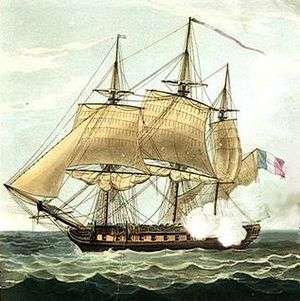French frigate Iphigénie (1810)
The French frigate Iphigénie was a Pallas-class frigate of a nominal 44 guns, launched in 1810. The British captured her in 1814. The British named her HMS Palma, and then renamed her HMS Gloire. She was sold in 1817, never having been commissioned into the Royal Navy.
 Clorinde, sister-ship of French frigate Iphigénie (1810) | |
| History | |
|---|---|
| Name: | Iphigénie |
| Laid down: | May 1809 |
| Launched: | 20 May 1810 |
| Captured: | 20 January 1814 |
| Name: | Palma |
| Acquired: | 20 January 1814 (by capture) |
| Renamed: | HMS Gloire |
| Fate: | Sold 1817 |
| General characteristics | |
| Class and type: | Pallas-class |
| Type: | frigate |
| Tonnage: | 106614⁄94 (bm) |
| Length: |
|
| Beam: | 39 ft 9 in (12.12 m) |
| Depth of hold: | 12 ft 7 1⁄2 in (3.848 m) |
| Propulsion: | Sails |
| Complement: |
|
| Armament: |
|
In 1813, along with Alcmène, she served at Cherbourg, in the squadron of contre-amiral Amable Troude, to protect the harbour.
Capture
In early 1814, Commander Jean-Léon Émeric was put in charge of a two-frigate squadron comprising Iphigénie and Alcmène, under Commander Ducrest de Villeneuve,[1] for a cruise between the Azores and Cap-Vert, off Guinea.
On 16 January 1814, the 74-gun third-rate ship of the line Venerable, her prize, the ex-French letter of marque brig Jason, and Cyane were in company when they spotted Alcmène and Iphigénie. After a chase that left Cyane far behind, Venerable captured Alcmène, though not without a fight. Venerable lost two men dead and four wounded, while the French lost 32 dead and 50 wounded.[2]
Jason and Cyane tracked Iphigénie and initially fired on her but broke off the engagement because they were outgunned. Cyane continued the chase for over three days until Venerable was able to rejoin the fight after having sailed 153 miles in the direction she believed that Iphigénie had taken. On 20 January, after a 19-hour chase, or what amounted in all to a four-day chase for Iphigénie, Venerable captured the quarry, having again left Cyane behind. In the chase, Iphigénie cast off her anchors and threw her boats overboard in order to try to gain speed. She apparently did not resist after Venerable came up.[2][Note 2] Before meeting up with the British ships, the two French vessels had taken some eight prizes.[4] The action resulted in the award in 1847, to any surviving claimants, of the Naval General Service Medal with clasps "Venerable 16 Jany 1814" and "Cyane 16 Jany. 1814".
Venerable was able to locate Iphigénie because Commander Ducrest de Villeneuve of Alcmène was so angry at Captain Émeric, who was the senior French commander, for not having come alongside Venerable on the other side also to board, that he essentially revealed the rendezvous instructions to Admiral Durham. (Venerable was Durham's flagship). When some prisoners from Iphigénie's crew were brought on Venerable, crew from Alcmène too were enraged. Durham had to station Royal Marines between them, with fixed bayonets, to prevent fighting from breaking out.[5]
Fate
A prize crew brought Iphigénie into Plymouth on 23 February 1814, and was laid up in ordinary. She was moved to Spithead in July. Capt. James A. Worth was in command of her, though she was never commissioned. The Admiralty named her Palma and then renamed her Gloire on 8 November. She was sold in September 1817 to a Mr. Freake for £1,750.[6]
Notes
- It is not clear that she actually was ever rearmed.
- A first-class share of the prize money for both vessels, including head money for Alcmène, was £819 16s 4½d; a sixth-class share, that of an ordinary seaman, for Iphigénie was worth £2 1s 8¼d. For Alcmène, a sixth-class share was worth £3 9s 4d.[3]
References
- Citations
- Fond Marine, t. 2, p. 495.
- Naval Chronicle, Vol. 31, pp.245-5.
- "No. 17048". The London Gazette. 5 August 1815. p. 1599.
- James & Chamier (1837), Vol. 6, pp.259-61.
- Long (1895), p. 199.
- Winfield (2008), p.181.
- Bibliography
- Fonds Marine. Campagnes (opérations; divisions et stations navales; missions diverses). Inventaire de la sous-série Marine BB4. Tome deuxième : BB4 1 à 482 (1790-1826)
- James, William & Frederick Chamier (1837) The naval history of Great Britain : from the declaration of war by France in 1793 to the accession of George IV. (London: R. Bentley).
- Long, William H. (1895) Medals of the British navy and how they were won: with a list of those officers, who for their gallant conduct were granted honorary swords and plate by the Committee of the Patriotic Fund. (London: Norie & Wilson).
- Winfield, Rif (2008). British Warships in the Age of Sail 1793–1817: Design, Construction, Careers and Fates. Seaforth. ISBN 1-86176-246-1.